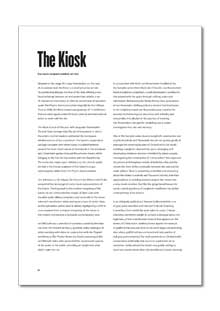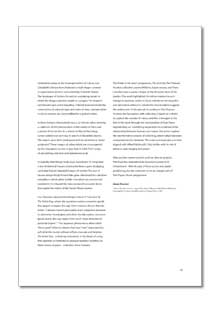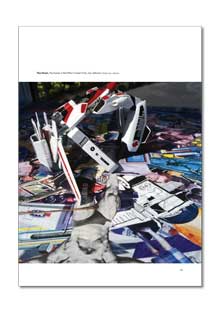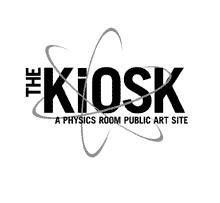 |
|||||||||
|
|
| ...Publications: Annual | ...The Physics Room Annual 2004 | |||||||||||||
|
The Kiosk. Situated on the verge of a major intersection, on the cusp of an outdoor mall, the Kiosk is a small yet active art site. Its positioning disrupts the flow of the mall, offering a nonfiscal exchange between art and pedestrians amidst a run of commercial enterprises. In 2004, its second year of operation under The Physics Room (conceived originally by the Oblique Trust in 2000), the Kiosk hosted a programme of 11 exhibitions that provided opportunities for local, national and international artists to work with the site. The Kiosk kicked off the year with Jacquelyn Greenbank’s The Irish State Carriage Visits The Isle Of Greenbank, in which the artist’s crochet mastery celebrated the homespun wholesomeness of tea-cosy kitsch. The Queen’s resplendent carriage complete with white horses trundled fruitlessly around the small island nation of Greenbank. In this miniature epic Greenbank gently critiqued the princess-dream whilst bringing to the fore her fascination with the Royal family. The scene also made a pert reference to the crime in public art that is the bronze sculpture of the Queen’s corgis, unfortunately visible from The Physics Room window. Jess Johnson’s sci-fi critique, The Future Is Not What It Used To Be, unravelled the stereotypical comic book representations of the future. Thinking back to the modern imagining of the future, we are confounded by images of silver suits with shoulder pads, talking computers and monorails to the moon. Johnson’s transformer robot, resting on a base of rocket ships and bodybuilders, arches back in defeat, highlighting a shift in consciousness from a utopian imagining of the future in the modern era towards a dystopian contemporary view. outTAKEout# was a selection of outtakes curated by Brendan Lee, from the Projekt# archive, a quarterly video catalogue of artists working with video. In conjunction with the Projekt# exhibition at The Physics Room, the Kiosk’s screening of the outTAKEout# video edits presented the ‘unanchored’ aspects of the works to the public, providing an insight into what didn’t make the cut. In conjunction with Karin van Roosmalen’s installation for the Sampler series titled Much Like A Traveller, van Roosmalen’s Kiosk installation comprised a small dressmaker’s workbench that played with the space through shifting scales and dimensions. Referencing her family history (two generations of van Roosmalen clothing industry workers had businesses in the neighbourhood) van Roosmalen gave a nod to her ancestry by fashioning her structures with a fluidity and temporality that alluded to the practice of tailoring. Van Roosmalen’s site specific modelling was a subtle investigation into site and memory. Also in the Sampler series, Joanna Langford’s construction out of pink Hundreds and Thousands biscuits sat quietly, gently lit, amongst the towering facades of Christchurch’s old world buildings. Langford colonised the space, arranging and developing miniature environs inhabited by plastic people, investigating the construction of “communities” that represent the private and imaginary worlds of both the artist and the viewer. Her work shifts continually between the real and the make believe. There is something so familiar and reassuring about the fabled Hundreds and Thousand biscuits, that their appropriation as building material propels the viewer into a story book narrative. And like the gingerbread house, the candy-coated goodness of Langford’s installation has darker underpinnings if we read on. In an obliquely political act, Treason Sedito installed a can of grey paint stencilled with the text ‘Cultural Cleansing Committee’, from which the work takes its name. Cultural Cleansing Committee sought to activate a dialogue about the legitimacy of the unauthorised artwork that appears on the streets of Christchurch. Sedito’s protest against the removal of graffiti in the area was born as the artist began documenting sites where graffiti had been removed and only patches of dull grey paint remained.The work comments on Christchurch’s conservative underbelly that seems to repel street art as vandalism. Sedito utilised the Kiosk’s very public setting to voice her concern about what she describes as ‘cultural cleansing’. Similarly focusing on the homogenisation of culture, Lee Campbell’s Chinese Burns featured a small dragon covered in supermarket stickers surrounded by ‘Oriental’ stickers. The landscape of stickers formed an undulating terrain in which the dragon seemed unable to navigate. The dragon’s luminescent eyes and a beguiling ‘Oriental’ tune examined the construction of universal signs and codes of mass commercialism in which cultures are commodified for a global market. Andrew Eyman’s Streetymades was a 22-minute video showing a collection of 600 photos taken in the streets of Paris over a period of six months. In a tribute to Marcel Duchamp, Eyman walked out each day in search of discarded objects. The objects were then catalogued and documented as “street sculptures”. These images of urban debris are accompanied by the ubiquitous sounds of gay Paris in Edith Piaf’s songs of sad endings, lost love and abandoned souls. In typically slick Wayne Youle style, Exploitation St comprised a row of identical houses constructed from a pack of playing cards that feature historical images of wahine. The row of houses and perfectly formed fake grass referenced the suburban mentality in which white middle-class ideals are constructed. Exploitation St critiqued the mass-produced consumer items that exploit the notion of the “exotic” Maori woman. Lisa Clements explored the benign nature of “cuteness” in The Artlist Dog, where she questions useless consumer goods that appeal to buyers through their cuteness. Sharon Kinsella writes "Cuteness loaned personality and a subjective presence to otherwise meaningless and often literally useless consumer goods and in this way made them much more attractive to potential buyers".1 This Japanese phenomena, often called “fancy good” refers to objects that have “cute” characteristics: soft, infantile, round, without orifices, insecure and helpless. The Artlist Dog - a drawing instrument in the shape of a dog that operates on batteries to produce mindless scribbles on blank sheets of paper - embodies these features. The finale to the year’s programme, The Birds (by The Pleasure Hunters collective Leanne Williams, Susan Jowsey and Fiona Lascelles) was a quirky critique of the Victorian ideal of the Garden. The work highlighted the elitism evident in such indulgent pastimes, where to focus entirely on the beautiful and decorative without a concern for functionalism suggests the uselessness of the pursuit. According to The Pleasure Hunters, the fascination with collecting is based on a desire to capture the wonder of nature, and this is brought to the fore in the work through the incorporation of faux-fauna representing our underlying desperation to understand the relationship between humans and nature. The artists explore the transformative process of collecting, where nature becomes subsumed into the domestic. The work communicates a tension aligned with Alfred Hitchcock’s 1963 thriller, with its mix of pleasure, pain, longing and power. After another twelve months and ten diverse projects, The Kiosk has maintained an important presence in Christchurch. With its easy 24-hour access and public positioning, the site continues to be an integral part of The Physics Room programme. Danae Mossman 1 Sharon Kinsella, ‘Cuties in Japan’ from Skov & Moeran (eds),Women Media and Consumption in Japan. Hawaii:University of Hawaii Press, 1995. View The Kiosk. Essay by Danae Mossman as a PDF This essay originally appeared in The Physics Room Annual 2004 Order your copy today from The Physics Room ! Related
|
|||||||||||||




